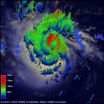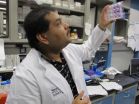University of Alberta medical scientists first in the world to look at structure of vital molecule
2012-09-07
(Press-News.org) Molybdenum is an essential metal required in all living beings from bacteria to plants to humans. But as vital as this metal is, no one understood the importance of its structure until the Faculty of Medicine & Dentistry's Joel Weiner and his team jumped on the case.
Molybdenum plays critical roles in human health. It does not act alone but is found attached to certain proteins, called molybdenum enzymes, by a very large organic molecule. The organic molecule that holds the molybdenum in place in a protein is extraordinarily complex. and "expensive" for the cell to make, b But the structure of this molecule should make sense to scientists now, thanks to Weiner and his research team.
For starters, the research group found that the molecule occurs in nature in two forms based on their appearance – flat or distorted. Weiner's team was able to show that the distorted form and flat form have very different functions. The distorted molecule plays a role in the transfer of electrons to the molybdenum, whereas the flat molecule prepares and co-ordinates positioning of the enzyme so it can be part of a biochemical reaction.
"This is important because molybdenum is so essential throughout biology," said Weiner. "We need to understand why the cell goes to all this trouble."
The distorted form is found in proteins involved in metabolic, respiratory and cardiac diseases. The flat form occurs in a protein required for brain development, and defects in this protein cause death in infancy. Understanding of this flat form could help lead to treatment of this defect.
It all started for Weiner and his research group in the Department of Biochemistry about three years ago. Although scientists worldwide had known the overall structure of molybdenum in proteins for many years, no one understood why it is so complicated. It was a summer student, Matthew Solomonson, who noticed that one of the structures holding molybdenum was very flat while the other group was distorted. As curiosity-based research goes, the summer student and Weiner's research team wondered if it was significant. The answer is yes.
"When you bring in a new student it's really good because they have a fresh way of looking at things," says Weiner of Solomonson who is now a grad student at the University of British Columbia.
"This discovery is a major one for my lab and will have a huge impact on molybdenum biochemistry research."
Now the team will use protein-engineering techniques to change the protein environment around the molybdenum.
"This is a critical next step," said Weiner. "We hope to finally start understanding the chemistry of these enzymes at atomic resolution, and to modulate their activities to better understand human disease and explore potential biotechnology and biomedical applications."
###
This work is published in the high-impact journal Proceedings of the National Academy of Sciences. This study was funded by the Canadian Institutes of Health Research.
ELSE PRESS RELEASES FROM THIS DATE:
2012-09-07
People who have had kidney stones are twice as likely to need dialysis or a kidney transplant later in life, demonstrates recently published findings by medical researchers at the University of Alberta. Their article was recently published in the British Medical Journal.
Faculty of Medicine & Dentistry researchers Todd Alexander and Marcello Tonelli tracked data of more than three million Albertans over an 11-year period from 1997 to 2009. They discovered those with a history of kidney stones were twice as likely to have serious kidney problems later in life when compared ...
2012-09-07
The Atlantic Ocean hurricane season spawned two hurricanes this week and NASA satellites have been monitoring them and providing valuable data to forecasters. NASA's TRMM satellite saw very heavy rainfall and powerful towering thunderstorms in Michael when the storm became a hurricane. Michael's wind speeds more than doubled in 24 hours and it is now a major hurricane on the Saffir-Simpson scale.
Tropical Storm Michael became a hurricane on Sept. 5 and NASA's Tropical Rainfall Measuring Mission (TRMM) satellite passed by and collected data on rainfall and cloud heights. ...
2012-09-07
Sorting good data from bad is critical when analyzing microscopic structures like cells and their contents, according to researchers at Rice University. The trick is to find the right window of time through which to look.
A new paper by the Rice lab of Angel Martí, an assistant professor of chemistry and bioengineering, offers a methodology to optimize the sensitivity of photoluminescent probes using time-resolved spectroscopy. Martí and co-author Kewei Huang, a graduate student in his group, found their technique gave results nearly twice as good as standard fluorescence ...
2012-09-07
Adding the monoclonal antibody bavituximab to docetaxel chemotherapy doubles overall response rate and improves progression-free survival and overall survival in late-stage non-squamous, non-small cell lung cancer (NS-NSCLC) patients who have already received one prior chemotherapy regimen, according to research presented at the 2012 Chicago Multidisciplinary Symposium in Thoracic Oncology. This symposium is sponsored by the American Society of Clinical Oncology (ASCO), the American Society for Radiation Oncology (ASTRO), the International Association for the Study of Lung ...
2012-09-07
This press release is available in French.Researchers from the Guy Rouleau Laboratory affiliated with the CHUM Research Centre and the CHU–Sainte-Justine Research Centre have discovered the genetic cause of a rare disease reported only in patients originating from Newfoundland: hereditary spastic ataxia (HSA).
This condition is characterized by lower-limb spasticity (or stiffness) and ataxia (lack of coordination), the latter leading to speech and swallowing problems, and eye movement abnormalities. The disease is not deadly, but people start developing gait problems ...
2012-09-07
Stage I, non-small cell lung cancer (NSCLC) patients who received radiation therapy have an increased median survival of 21 months compared to 16 months, and the percentage of patients who receive no treatment declined from 20 percent to 16 percent, respectively, when comparing the two eras evaluated, 1999-2003 and 2004-2008, according to detailed analysis of the SEER-17 (Surveillance Epidemiology and End Results, National Cancer Institute) national database presented at the 2012 Chicago Multidisciplinary Symposium in Thoracic Oncology. This symposium is sponsored by the ...
2012-09-07
Stage III non-small cell lung cancer (NSCLC) patients treated with surgery and/or radiation therapy have a significantly reduced risk of developing brain metastases if they also receive prophylactic cranial irradiation (PCI); however, this study did not show an improvement in overall survival with PCI, according to research presented at the 2012 Chicago Multidisciplinary Symposium in Thoracic Oncology. This symposium is sponsored by the American Society of Clinical Oncology (ASCO), the American Society for Radiation Oncology (ASTRO), the International Association for the ...
2012-09-07
TORONTO, Sept. 6, 2012 – Imagine that the players on your favourite football team were smaller than their opponents, and had to play without helmets or pads. Left defenseless, they would become easy prey for other teams. Similarly, changes in Canadian lake water chemistry have left small water organisms vulnerable to their predators, which may pose a serious environmental threat, according to a new study.
"At low calcium levels the organisms grow slower and cannot build their armour," says study lead author Howard Riessen, professor of biology, SUNY College at Buffalo. ...
2012-09-07
Treatment with pemetrexed, carboplatin and bevacizumab followed by maintenance pemetrexed and bevacizumab (Pem+Cb+B) is no better than standard therapy with paclitaxel, carboplatin and bevacizumab followed by bevacizumab (Pac+Cb+B) in patients with advanced non-squamous non-small cell lung cancer (NS-NSCLC), according to research presented at the 2012 Chicago Multidisciplinary Symposium in Thoracic Oncology. This symposium is sponsored by the American Society of Clinical Oncology (ASCO), the American Society for Radiation Oncology (ASTRO), the International Association ...
2012-09-07
SAN ANTONIO (Sept. 6, 2012) — RSV, a virus that causes respiratory infections in infants and young children, selectively kills cancer cells while leaving healthy cells alone, researchers from the School of Medicine at The University of Texas Health Science Center San Antonio said.
Santanu Bose, Ph.D., of the School of Medicine, is the inventor on a pending U.S. patent of RSV as an oncolytic therapy. This represents a new use for the virus. Bandana Chatterjee, Ph.D., of the School of Medicine and the South Texas Veterans Health Care System, is the co-inventor. Oncolytic ...
LAST 30 PRESS RELEASES:
[Press-News.org] University of Alberta medical scientists first in the world to look at structure of vital molecule

